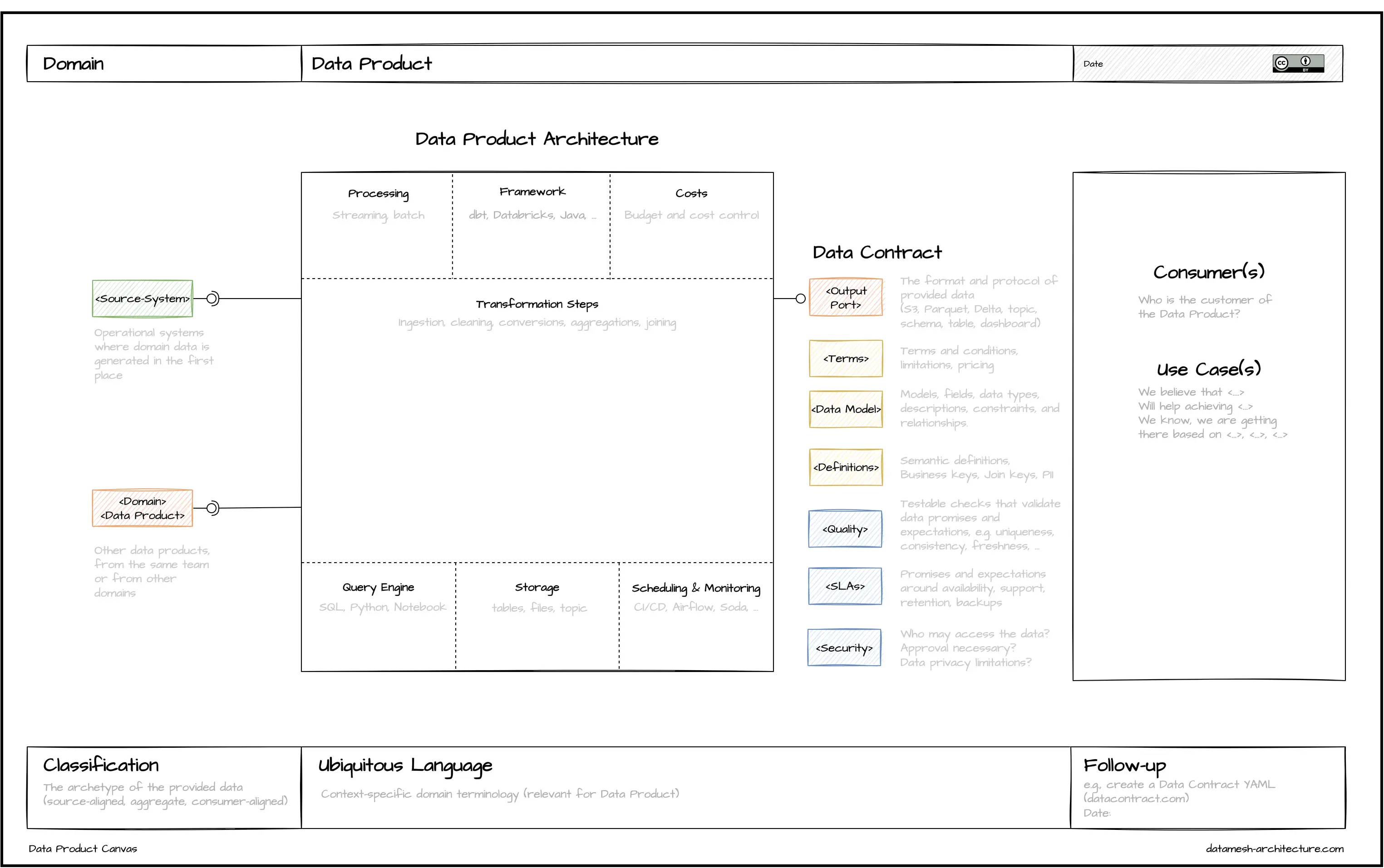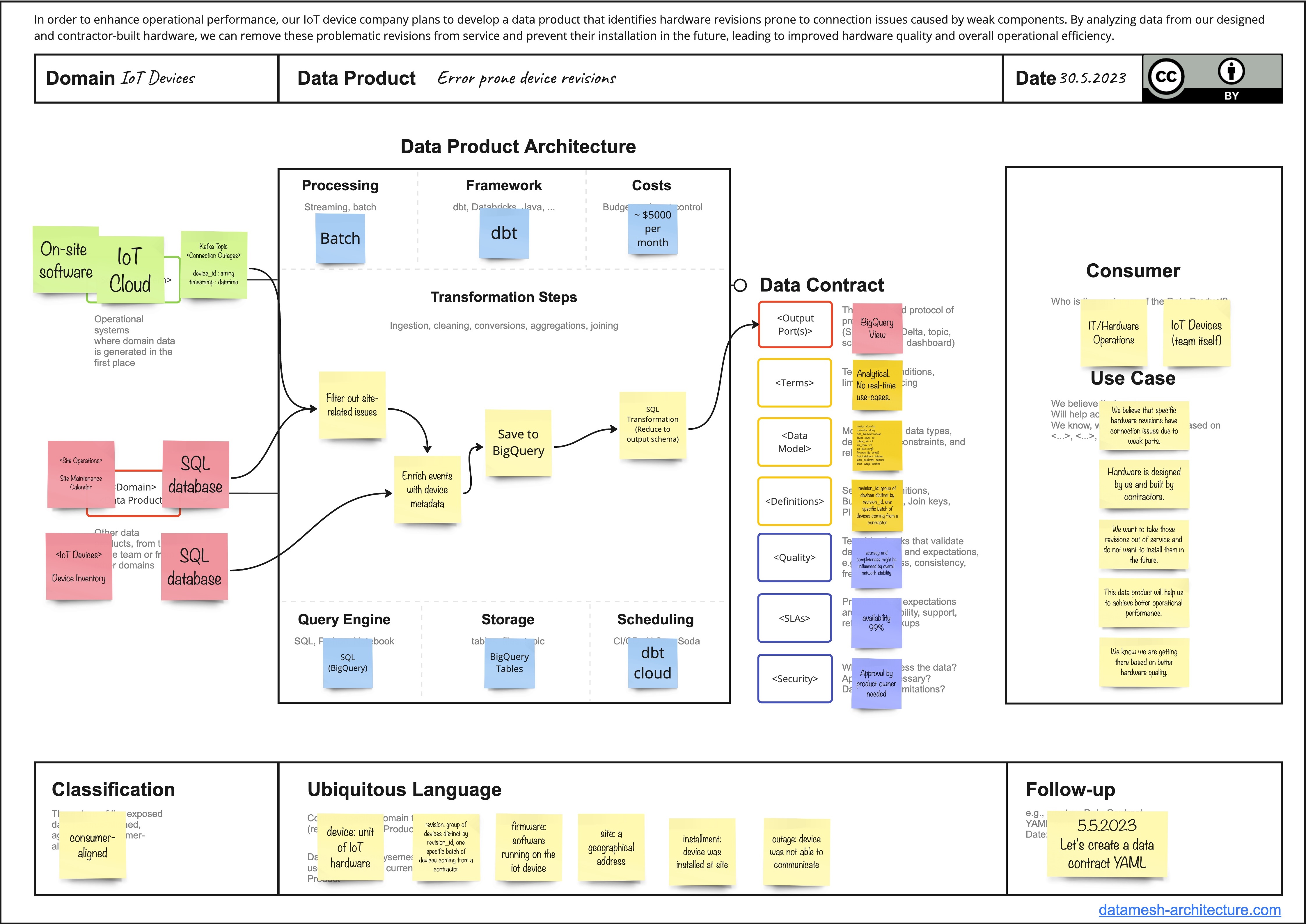According to J. Majchrzak et al., a "data product is an autonomous, read-optimized, standardized data unit containing at least one dataset (Domain Dataset), created for satisfying user needs". Conceptually, a mesh is a graph, a network, consisting of nodes and connecting edges. Each node in a data mesh is called data product. Every data product exists within a bounded context and one bounded context might contain several data products.
As with every architecture, data architecture also has a sociotechnical perspective. Therefore, we need to consider people and processes in addition to technology for data management. Furthermore, because we have consumers for our data, these consumers expect a certain quality. Therefore, our data need to be accessible, and everyone should know where to find data. Thus, the sociotechnical perspective pushes us to adopt the product thinking philosophy for data - data products.
What could be a data product? Generally, any data representation that has value for its consumers can be a good candidate. In the following, you will find a list of examples of possible data products:
- A database table or view
- Raw unstructured files: e.g., images or videos uploaded by users of a video portal; however, to be valuable to consumers, they should be provided with metadata
- Data stream of data entities from a transaction system
- Data stream representing the history of changes to the application: For example, events that relate to changes made within a billing account
- Simple files: Data in CSV format, excel files
- Partitioned files in optimized (Parquet) format
- REST API: Read-optimized data exposed from applications
- Master Data Management database
- Features for the machine learning models
- Visualizations and dashboard
Data Product Canvas
To establish a structured process of data product design across an organization, we propose to start with a Data Product Canvas.
A Data Product Canvas is a visual framework that guides your team through the data product specification. We suggest to fill out this canvas collaboratively. In total, the Data Product Canvas consists of eight building blocks:
- Domain
- Data Product Name
- Consumer and Use Case
- Data Contract
- Sources
- Data Product Architecture
- Ubiquitous Language
- Classification
In the following, we describe each of the building blocks that constitute the data product. The order of the building blocks represents the recommended sequence of the collaborative steps during the workshop.
Domain
Each data product should be implemented, evolved, and maintained by one domain team only. Therefore each data product belongs exactly to one domain. The following possible questions are relevant in this building block:
- Who is accountable for the data product?
- Who specifies its requirements?
- Who will answer questions about the data product?
- Who fixes it when it breaks?
Data Product Name
Each data product has a unique name to be identified and accessed within an organization. Typically, the product name should follow the common naming strategy.
Consumer and Use Case(s)
This building block describes the reason behind the existence of the data product. Data product design follows the "Product Thinking" philosophy. We always start with the consumer needs.
To identify the purpose of the data product, we describe analytical use cases and organizational objectives. Understanding the use cases is essential to specify the data required to implement the use cases. The consumer of the future data product might be either our own domain team or different domain teams.
Data Contract
The output ports define the format and consumption protocol in which data can be exposed. For example, the output port can be a database table, file, API, or visualizations.
The data contract defines its interface and metadata.
- The terms describe how data can be used, limitations, and pricing
- The data model part describes attributes, data types, constraints, and relationships to other elements in the data unit (e.g., functional dependencies)
- The semantics part provides description about the logical model of the data unit.
Sources
This building block describes the input data for the future data product. The input ports are receiving mechanism for data that will constitute the data product. The input ports define the format and protocol in which data can be read. We distinguish here between operational source systems and other data products, which might be either internal or coming from other domains.
Data Product Architecture
This is the core building block where we design the internals of the data product. This is the place to specify everything between the input and output ports. Please, describe everything you need to design a data product on a conceptual level. For instance, you might describe data ingestion, storage, transport, wrangling, cleaning, transformations, enrichment, augmentation, analytics, SQL statements, or data platform services.
Ubiquitous Language
Describe here a common language that is shared between everyone involved in the project. This is usually a context-specific domain terminology that is relevant for operational systems and data product.
Classification
In this block, we specify the nature of the exposed data, meaning, we classify our data product as either, source-aligned, aggregate, or consumer-aligned.
Collaborate Together
The proposed canvas is suitable for working collaboratively on data products design. The canvas might be easily used either plotted on paper or with the common online whiteboards like Miro. Once your organization has created a collection of data products using the proposed data product canvas, you can start connecting all data products and produce an actual data mesh.
Data Product Canvas Example
We've created an example for a data product containing error prone device revisions within the IoT devices domain.
Download Template
The Data Product Canvas is free to use under the CC BY 4.0 license.
Follow-up
- Data Mesh Canvas to visualize a data product landscape
- Data Contract Specification to elaborate a formal version of the data contract as YAML
- Consulting from INNOQ to facilitate data product workshops or to get help with data product implementation

